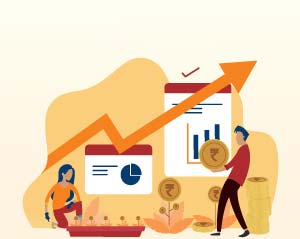The CIBIL Score is a three-digit number, between 300 and 900, indicating your creditworthiness and loan repayment capacity.
The credit agency, Credit Information Bureau (India) Ltd. (CIBIL), generates credit reports for all Indians based on their credit history and then assigns a numerical value, the CIBIL score, to represent their past credit behaviour. This number reflects how responsible you are in handling credit. This will help you to develop healthy credit behaviour. A good credit score shows timely repayments of dues and reduces the odds of new credits sanctioned to you remaining unpaid. The higher your CIBIL score, the better.
Importance of checking CIBIL Score
Periodically checking your CIBIL report keeps you aware of any drop in the score. You can then take steps to recover it.
The benefits of a higher CIBIL score include:
- Availability of lower interest rates on loans
- Higher chances of credit approval
- Access to a wide range of credit cards with higher credit limits
If your CIBIL Score falls below the range financial institutions consider acceptable, you should try to improve it. But first, you need to understand the factors that contribute to your CIBIL Score calculations. This will help you develop healthy credit behaviour.
Calculation of CIBIL Score
The credit bureau feeds your financial data into a proprietary algorithm with several variables. Each carries a different weightage. However, the principal elements determining the score include:
- History of repayment: Missed EMI due dates and non-payments lower your credit score.
- Credit exposure: Your outstanding dues on credit accounts influence the potential of defaults on new credit lines you open. The higher the sum unpaid, the greater the risk to new lenders, since it indicates you are already overburdened with loans. Thus, this value hurts your credit score.
Also, if you have used up most of your available credit, financers will consider you a risky borrower. - Credit mix: A balanced mix of loans secured with collaterals and unsecured loans positively influences the score. Credit card dues and personal loans are considered unsecured, while home mortgages and auto loans are secured ones.
- New credit applications: Your CIBIL Score takes a hit if you apply for new loans or credit cards frequently, within a short period. It makes you appear credit-hungry.
- Credit duration: Using credit for a long time and paying it back without fail boosts your credit score.
Tips to improve CIBIL score
- Review your credit report: Check the details to see if any loans you have already settled are still showing as open. Also, verify if the report has assigned to your name any credit not belonging to you. If you find any such errors, request for corrections.
- Limit credit usage: Avoid increasing your credit use beyond 30% of your sanctioned credit limit.
- Increase credit limit: Try to repay most of your loans’ principal amount and your credit card bills in full. It will free up credit for future use.
- Make payments on time: Make loan and credit card bill payments a priority. Establish that you can repay your loans efficiently.
CIBIL Score Range
- NA/NH: No credit history.
- 350 – 549: Bad CIBIL Score indicating a high-risk borrower.
- 550 – 649: Fair, but fewer loan options.
- 650 – 749: Increased credit eligibility but no leverage for interest rate negotiations.
- 750 – 900: 79% of loans are sanctioned to consumers with a CIBIL Score greater than 7501
If you want to reap the benefits of a good CIBIL Score, you must avoid habits that can bring it down.
Factors that can affect your CIBIL Score
- Dependency on unsecured credit: Avoid having multiple personal loans or credit cards, and making frequent requests for credit cards.
- Delaying credit card payments: Set reminders or automate the debits from your bank account to avoid missing due dates.
- Having several credit cards: Cancel dormant cards and stick to using a single credit card.
People like you also read ...





